States and union territories of India
India is a federal union comprising 28 states and 8 union territories,[1] with a total of 36 entities. The states and union territories are further subdivided into districts and smaller administrative divisions.
| States and union territories of India ordered by |
|---|
|
| States and union territories of India | |
|---|---|
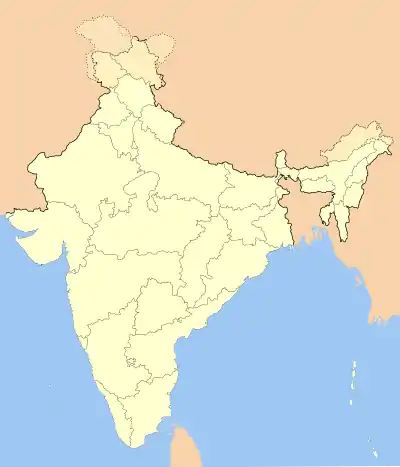
Jammu
and Kashmir Telangana
Dadra and Nagar Haveli and
Daman and Diu Puducherry
| |
| Category | Federated states |
| Location | Republic of India |
| Number | 28 States 8 Union territories |
| Populations | States: Sikkim – 610,577 (lowest) Uttar Pradesh – 199,812,341 (highest) Union Territories: Lakshadweep – 64,473 (lowest) Delhi – 16,787,941 (highest) |
| Areas | States: Goa – 3,702 km2 (1,429 sq mi) (smallest) Rajasthan – 342,269 km2 (132,151 sq mi) (largest) Union territories: Lakshadweep – 32 km2 (12 sq mi) (smallest) Ladakh – 59,146 km2 (22,836 sq mi) (largest) |
| Government |
|
| Subdivisions |
|
 |
|---|
|
History
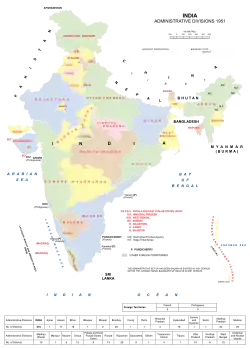
Pre-independence
The Indian subcontinent has been ruled by many different ethnic groups throughout its history, each instituting their own policies of administrative division in the region.[2][3][4][5][6][7][8][9][10][11][12] The British Raj mostly retained the administrative structure of the preceding Mughal Empire. India was divided into provinces (also called Presidencies), directly governed by the British, and princely states, which were nominally controlled by a local prince or raja loyal to the British Empire, which held de facto sovereignty (suzerainty) over the princely states.
1947–1950
Between 1947 and 1950 the territories of the princely states were politically integrated into the Indian union. Most were merged into existing provinces; others were organised into new provinces, such as Rajasthan, Himachal Pradesh, Madhya Bharat, and Vindhya Pradesh, made up of multiple princely states; a few, including Mysore, Hyderabad, Bhopal, and Bilaspur, became separate provinces. The new Constitution of India, which came into force on 26 January 1950, made India a sovereign democratic republic. The new republic was also declared to be a "Union of States".[13] The constitution of 1950 distinguished between three main types of states:
- Part A states, which were the former governors' provinces of British India, were ruled by an elected governor and state legislature. The nine Part A states were:
- Assam (formerly Assam Province),
- Bihar (formerly Bihar Province),
- Bombay (formerly Bombay Province),
- East Punjab (formerly Punjab Province),
- Madhya Pradesh (formerly the Central Provinces and Berar),
- Madras (formerly Madras Province),
- Orissa (formerly Orissa Province),
- Uttar Pradesh (formerly the United Provinces), and
- West Bengal (formerly Bengal Province).
- The eight Part B states were former princely states or groups of princely states, governed by a rajpramukh, who was usually the ruler of a constituent state, and an elected legislature. The rajpramukh was appointed by the President of India. The Part B states were:
- Hyderabad (formerly Hyderabad Princely State),
- Jammu and Kashmir (formerly Jammu and Kashmir Princely State),
- Madhya Bharat (formerly Central India Agency),
- Mysore (formerly Mysore Princely State),
- Patiala and East Punjab States Union (PEPSU),
- Rajasthan (formerly Rajputana Agency),
- Saurashtra (formerly Baroda, Western India and Gujarat States Agency), and
- Travancore–Cochin (formerly Travancore Princely State and Cochin Princely State).
- The ten Part C states included both the former chief commissioners' provinces and some princely states, and each was governed by a chief commissioner appointed by the President of India. The Part C states were:
- Ajmer (formerly Ajmer-Merwara Province),
- Bhopal (formerly Bhopal Princely State),
- Bilaspur (formerly Bilaspur Princely State),
- Coorg State (formerly Coorg Province),
- Delhi,
- Himachal Pradesh,
- Kutch (formerly Cutch Princely State),
- Manipur (formerly Manipur Princely State),
- Tripura (formerly Tripura Princely State), and
- Vindhya Pradesh (formerly Central India Agency).
- The only Part D state was the Andaman and Nicobar Islands, which were administered by a lieutenant governor appointed by the union government.
States reorganisation (1951–1956)
Andhra State was created on 1 October 1953 from the Telugu-speaking northern districts of Madras State.[14]
The French enclave of Chandernagore was transferred to West Bengal in 1954. In the same year Pondicherry, comprising the former French enclaves of Pondichéry, Karikal, Yanaon and Mahé, was transferred to India; this became a union territory in 1962.[15]
Also in 1954, pro-India forces liberated the Portuguese-held enclaves of Dadrá and Nagar Aveli, declaring the short-lived de facto state of Free Dadra and Nagar Haveli. In 1961, India annexed it as the Union Territory of Dadra and Nagar Haveli.[16][17][18][19]
The States Reorganisation Act, 1956 reorganised the states based on linguistic lines resulting in the creation of the new states.[20]
As a result of this act:
- Madras State retained its name, with Kanyakumari district added to form Travancore–Cochin.
- Andhra Pradesh was created with the merger of Andhra State with the Telugu-speaking districts of Hyderabad State in 1956.
- Kerala was created by merging Malabar district and the Kasaragod taluk of South Canara districts of Madras State with Travancore–Cochin.
- Mysore State was re-organized with the addition of the districts of Bellary and South Canara (excluding Kasaragod taluk) and the Kollegal taluk of Coimbatore district from the Madras State, the districts of Belgaum, Bijapur, North Canara and Dharwad from Bombay State, the Kannada-majority districts of Bidar, Raichur and Kalaburagi from Hyderabad State and the Coorg State.
- The Laccadive Islands, Aminidivi Islands and Minicoy Island, which had been divided between the South Canara and Malabar districts of Madras State, were united and organised into the union territory of Lakshadweep.
- Bombay State was enlarged by the addition of Saurashtra State and Kutch State, the Marathi-speaking districts of Nagpur division of Madhya Pradesh and the Marathwada region of Hyderabad State.
- Rajasthan and Punjab gained territories from Ajmer State and Patiala and East Punjab States Union respectively and certain territories of Bihar were transferred to West Bengal.
Post-1956
Bombay State was split into the linguistic states of Gujarat and Maharashtra on 1 May 1960 by the Bombay Reorganisation Act.[21] The former Union Territory of Nagaland achieved statehood on 1 December 1963.[22] The Punjab Reorganisation Act, 1966 resulted in the creation of Haryana on 1 November and the transfer of the northern districts of Punjab to Himachal Pradesh.[23] The act also designated Chandigarh as a union territory and the shared capital of Punjab and Haryana.[24][25]
Madras State was renamed Tamil Nadu in 1969. The north-eastern states of Manipur, Meghalaya and Tripura were formed on 21 January 1972.[26] Mysore State was renamed Karnataka in 1973. On 16 May 1975, Sikkim became the 22nd state of the Indian Union and the state's monarchy was abolished.[27] In 1987, Arunachal Pradesh and Mizoram became states on 20 February, followed by Goa on 30 May, while erstwhile union territory of Goa, Daman and Diu's northern exclaves Damão and Diu became a separate union territory as Daman and Diu.[28]
In November 2000, three new states were created, namely:
- Chhattisgarh, from eastern Madhya Pradesh,
- Uttaranchal, from northwest Uttar Pradesh (renamed Uttarakhand in 2007), and
- Jharkhand, from southern districts of Bihar with the enforcement of Madhya Pradesh Reorganisation Act, 2000, Uttar Pradesh Reorganisation Act, 2000 and Bihar Reorganisation Act, 2000 respectively.[29][30][31][32]
Pondicherry was renamed Puducherry in 2007 and Orissa was renamed Odisha in 2011. Telangana was created on 2 June 2014 from ten former districts of north-western Andhra Pradesh.[33][34]
In August 2019, the Parliament of India passed the Jammu and Kashmir Reorganisation Act, 2019, which contains provisions to reorganise the state of Jammu and Kashmir into two union territories; Jammu and Kashmir and Ladakh, effective from 31 October 2019.[35] Later that year in November, the Government of India introduced legislation to merge the union territories of Daman and Diu and Dadra and Nagar Haveli into a single union territory to be known as Dadra and Nagar Haveli and Daman and Diu, effective from 26 January 2020.[36][37][38]
States and Union territories
States
| State | ISO | Vehicle code |
Zone | Capital | Largest city | Statehood | Population (2011) |
Area (km2) |
Official languages[39] |
Additional official languages[39] |
|---|---|---|---|---|---|---|---|---|---|---|
| Andhra Pradesh | IN-AP | AP | Southern | Amaravati | Visakhapatnam | 1 November 1956 | 49,506,799 | 162,975 | Telugu | — |
| Arunachal Pradesh | IN-AR | AR | North-Eastern | Itanagar | 20 February 1987 | 1,383,727 | 83,743 | English | — | |
| Assam | IN-AS | AS | North-Eastern | Dispur | Guwahati | 26 January 1950 | 31,205,576 | 78,550 | Assamese | Bengali, Bodo |
| Bihar | IN-BR | BR | Eastern | Patna | 26 January 1950 | 104,099,452 | 94,163 | Hindi | Urdu | |
| Chhattisgarh | IN-CT | CG | Central | Raipur[lower-alpha 1] | 1 November 2000 | 25,545,198 | 135,194 | Chhattisgarhi | Hindi, English | |
| Goa | IN-GA | GA | Western | Panaji | Vasco da Gama | 30 May 1987 | 1,458,545 | 3,702 | Konkani | Marathi |
| Gujarat | IN-GJ | GJ | Western | Gandhinagar | Ahmedabad | 1 May 1960 | 60,439,692 | 196,024 | Gujarati | — |
| Haryana | IN-HR | HR | Northern | Chandigarh | Faridabad | 1 November 1966 | 25,351,462 | 44,212 | Hindi | Punjabi[40][41] |
| Himachal Pradesh | IN-HP | HP | Northern | Shimla (Summer) Dharamshala (Winter)[42] |
Shimla | 25 January 1971 | 6,864,602 | 55,673 | Hindi | Sanskrit[43] |
| Jharkhand | IN-JH | JH | Eastern | Ranchi | Jamshedpur | 15 November 2000 | 32,988,134 | 74,677 | Hindi | Angika, Bengali, Bhojpuri, Bhumij, Ho, Kharia, Khortha, Kurmali, Kurukh, Magahi, Maithili, Mundari, Nagpuri, Odia, Santali, Urdu[44][45] |
| Karnataka | IN-KA | KA | Southern | Bangalore | 1 November 1956 | 61,095,297 | 191,791 | Kannada | — | |
| Kerala | IN-KL | KL | Southern | Thiruvananthapuram | 1 November 1956 | 33,406,061 | 38,863 | Malayalam | English[46] | |
| Madhya Pradesh | IN-MP | MP | Central | Bhopal | Indore | 26 January 1950 | 72,626,809 | 308,252 | Hindi | — |
| Maharashtra | IN-MH | MH | Western | Mumbai (Summer) Nagpur (Winter)[47][48] |
Mumbai | 1 May 1960 | 112,374,333 | 307,713 | Marathi | — |
| Manipur | IN-MN | MN | North-Eastern | Imphal | 21 January 1972 | 2,855,794 | 22,347 | Meitei | English | |
| Meghalaya | IN-ML | ML | North-Eastern | Shillong | 21 January 1972 | 2,966,889 | 22,720 | English | Khasi[lower-alpha 2] | |
| Mizoram | IN-MZ | MZ | North-Eastern | Aizawl | 20 February 1987 | 1,097,206 | 21,081 | English, Hindi, Mizo | — | |
| Nagaland | IN-NL | NL | North-Eastern | Kohima | Dimapur | 1 December 1963 | 1,978,502 | 16,579 | English | — |
| Odisha | IN-OR | OD | Eastern | Bhubaneswar | 26 January 1950 | 41,974,218 | 155,820 | Odia | — | |
| Punjab | IN-PB | PB | Northern | Chandigarh | Ludhiana | 1 November 1966 | 27,743,338 | 50,362 | Punjabi | — |
| Rajasthan | IN-RJ | RJ | Northern | Jaipur | 26 January 1950 | 68,548,437 | 342,269 | Hindi | English | |
| Sikkim | IN-SK | SK | North-Eastern | Gangtok | 16 May 1975 | 610,577 | 7,096 | English, Nepali | Bhutia, Gurung, Lepcha, Limbu, Manggar, Mukhia, Newari, Rai, Sherpa, Tamang | |
| Tamil Nadu | IN-TN | TN | Southern | Chennai | 1 November 1956 | 72,147,030 | 130,058 | Tamil | English | |
| Telangana | IN-TG | TS | Southern | Hyderabad[lower-alpha 3] | 2 June 2014 | 35,193,978[53] | 112,077[53] | Telugu | Urdu[54] | |
| Tripura | IN-TR | TR | North-Eastern | Agartala | 21 January 1972 | 3,673,917 | 10,492 | Bengali, English, Kokborok | — | |
| Uttar Pradesh | IN-UP | UP | Central | Lucknow | 26 January 1950 | 199,812,341 | 243,286 | Hindi | Urdu | |
| Uttarakhand | IN-UT | UK | Central | Bhararisain (Summer) Dehradun (Winter)[55] |
Dehradun | 9 November 2000 | 10,086,292 | 53,483 | Hindi | Sanskrit[56] |
| West Bengal | IN-WB | WB | Eastern | Kolkata | 26 January 1950 | 91,276,115 | 88,752 | Bengali, Nepali[lower-alpha 4] | Hindi, Odia, Punjabi, Santali, Telugu, Urdu | |
- Naya Raipur is planned to replace Raipur as the capital city of Chhattisgarh.
- Khasi language has been declared as the Additional Official Language for all purposes in the District, Sub-Division and Block level offices of the State Government located in the Districts of Khasi-Jaintia Hills of Meghalaya.
- Andhra Pradesh was divided into two states, Telangana and a residual Andhra Pradesh on 2 June 2014.[49][50][51] Hyderabad, located entirely within the borders of Telangana, is to serve as the capital for both states for a period of time not exceeding ten years.[52] The Government of Andhra Pradesh and the Andhra Pradesh Legislature completed the process of relocating to temporary facilities in the envisaged new capital city Amaravati in early 2017.
- Bengali and Nepali are the Official Languages in Darjeeling and Kurseong sub-divisions of Darjeeling district.
Union territories
| Union territory | ISO 3166-2:IN | Vehicle code |
Zone | Capital | Largest city | UT established | Population | Area (km2) |
Official languages |
Additional official languages |
|---|---|---|---|---|---|---|---|---|---|---|
| Andaman and Nicobar Islands | IN-AN | AN | Southern | Port Blair | 1 November 1956 | 380,581 | 8,249 | Hindi | English | |
| Chandigarh | IN-CH | CH | Northern | Chandigarh | — | 1 November 1966 | 1,055,450 | 114 | English | — |
| Dadra and Nagar Haveli and Daman and Diu | IN-DH | DD | Western | Daman | 26 January 2020 | 586,956 | 603 | Hindi, Gujarati, Marathi, English | — | |
| Delhi | IN-DL | DL | Northern | New Delhi | Delhi | 1 November 1956 | 16,787,941 | 1,490 | Hindi, English | Punjabi, Urdu[57] |
| Jammu and Kashmir | IN-JK | JK | Northern | Srinagar (Summer)[58][59] Jammu (Winter)[59][60] |
Srinagar | 31 October 2019 | 12,258,433 | 42,241 | Kashmiri, Dogri, Urdu, Hindi, English | |
| Ladakh | IN-LA | LA | Northern | Leh (Summer) Kargil (Winter)[61] |
Leh | 31 October 2019 | 290,492 | 59,146 | Hindi, English | |
| Lakshadweep | IN-LD | LD | Southern | Kavaratti | 1 November 1956 | 64,473 | 32 | Malayalam, English | — | |
| Puducherry | IN-PY | PY | Southern | Puducherry | 16 August 1962 | 1,247,953 | 492 | Tamil, English | Telugu, Malayalam, French | |
Former states and union territories
Former states
| Map | State | Capital | Years | Present-day state(s) |
|---|---|---|---|---|
.svg.png.webp) |
Ajmer State | Ajmer | 1950–1956 | Rajasthan |
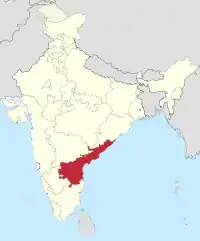 |
Andhra State | Kurnool | 1953–1956 | Andhra Pradesh |
.svg.png.webp) |
Bhopal State | Bhopal | 1949–1956 | Madhya Pradesh |
.svg.png.webp) |
Bilaspur State | Bilaspur | 1950–1954 | Himachal Pradesh |
.svg.png.webp) |
Bombay State | Bombay | 1950–1960 | Maharashtra, Gujarat, and partially Karnataka |
.svg.png.webp) |
Coorg State | Madikeri | 1950–1956 | Karnataka |
.png.webp) |
East Punjab | Shimla (1947–1953) Chandigarh (1953–1966) |
1947–1966 | Punjab, Haryana, Himachal Pradesh and Chandigarh UT |
.svg.png.webp) |
Hyderabad State | Hyderabad | 1948–1956 | Telangana, and partially Maharashtra and Karnataka |
_(claims_hatched).svg.png.webp) |
Jammu and Kashmir | Srinagar (Summer) Jammu (Winter) |
1952–2019 | Jammu and Kashmir UT and
Ladakh UT |
.svg.png.webp) |
Kutch State | Bhuj | 1947–1956 | Gujarat |
.svg.png.webp) |
Madhya Bharat | Indore (Summer) Gwalior (Winter) |
1948–1956 | Madhya Pradesh |
.svg.png.webp) |
Madras State | Madras | 1950–1969 | Andhra Pradesh, Tamil Nadu, and partially Karnataka and Kerala |
.svg.png.webp) |
Mysore State | Bangalore | 1947–1973 | Karnataka |
.svg.png.webp) |
Patiala and East Punjab States Union | Patiala | 1948–1956 | Punjab and Haryana |
.svg.png.webp) |
Saurashtra | Rajkot | 1948–1956 | Gujarat |
.svg.png.webp) |
Travancore–Cochin | Trivandrum | 1949–1956 | Kerala and partially Tamil Nadu |
.svg.png.webp) |
Vindhya Pradesh | Rewa | 1948–1956 | Madhya Pradesh |
Former union territories
| Map | Name | Zone | Capital | Area | UT established | UT disestablished | Now part of |
|---|---|---|---|---|---|---|---|
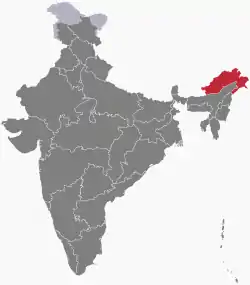 |
Arunachal Pradesh | North-Eastern | Itanagar | 83,743 km2 (32,333 sq mi) | 21 January 1972 | 20 February 1987 | As an Indian state |
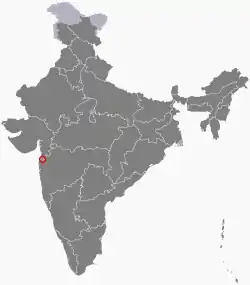 |
Dadra and Nagar Haveli | Western | Silvassa | 491 km2 (190 sq mi) | 11 August 1961 | 26 January 2020 | Dadra and Nagar Haveli and Daman and Diu union territory |
 |
Daman and Diu | Western | Daman | 112 km2 (43 sq mi) | 30 May 1987 | 26 January 2020 | Dadra and Nagar Haveli and Daman and Diu union territory |
 |
Goa, Daman and Diu | Western | Panaji | 3,814 km2 (1,473 sq mi) | 19 December 1961 | 30 May 1987 | Goa state and Dadra and Nagar Haveli and Daman and Diu union territory |
 |
Himachal Pradesh | Northern | Shimla | 55,673 km2 (21,495 sq mi) | 1 November 1956 | 25 January 1971 | As an Indian state |
 |
Manipur | North-Eastern | Imphal | 22,327 km2 (8,621 sq mi) | 1 November 1956 | 21 January 1972 | As an Indian state |
 |
Mizoram | North-Eastern | Aizawl | 21,087 km2 (8,142 sq mi) | 21 January 1972 | 20 February 1987 | As an Indian state |
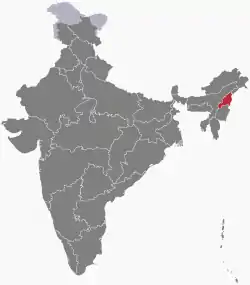 |
Nagaland | North-Eastern | Kohima | 16,579 km2 (6,401 sq mi) | 29 November 1957 | 1 December 1963 | As an Indian state |
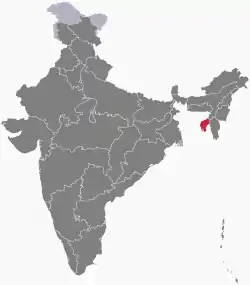 |
Tripura | North-Eastern | Agartala | 10,491.65 km2 (4,050.85 sq mi) | 1 November 1956 | 21 January 1972 | As an Indian state |
Responsibilities and authorities
The Constitution of India distributes the sovereign executive and legislative powers exercisable with respect to the territory of any State between the Union and that State.[62]
See also
- Administrative divisions of India
- Autonomous administrative divisions of India
- List of adjectives and demonyms for states and territories of India
- List of Indian state and union territory name etymologies
- List of princely states of British India (alphabetical)
- List of states and union territories of India by area
- List of states and union territories of India by population
- List of states in India by past population
- List of states of India by wildlife population
- Proposed states and union territories of India
References
- DelhiAugust 5. "States and Union Territories". Know India Programme. Retrieved 21 April 2020.
- Krishna Reddy (2003). Indian History. New Delhi: Tata McGraw Hill. ISBN 978-0-07-048369-9.
- Ramesh Chandra Majumdar (1977). Ancient India. Motilal Banarsidass Publishers. ISBN 978-81-208-0436-4.
- Romila Thapar (1966). A History of India: Part 1. [Harmondsworth] Penguin Books.
- V.D. Mahajan (2007). History of medieval India (10th ed.). New Delhi: S Chand. pp. 121, 122. ISBN 978-8121903646.
- Antonova, K.A.; Bongard-Levin, G.; Kotovsky, G. (1979). A History of India Volume 1. Moscow, USSR: Progress Publishers.
- Gupta Dynasty – MSN Encarta. Archived from the original on 29 October 2009.
- "India – Historical Setting – The Classical Age – Gupta and Harsha". Historymedren.about.com. 2 November 2009. Retrieved 16 May 2010.
- Nilakanta Sastri, K.A. (2002) [1955]. A history of South India from prehistoric times to the fall of Vijayanagar. New Delhi: Indian Branch, Oxford University Press. p. 239. ISBN 978-0-19-560686-7.
- Chandra, Satish. Medieval India: From Sultanate to the Mughals. p. 202.
- "Regional states, c. 1700–1850". Encyclopædia Britannica, Inc.
- Grewal, J. S. (1990). "Chapter 6: The Sikh empire (1799–1849)". The Sikh empire (1799–1849). The New Cambridge History of India. Vol. The Sikhs of the Punjab. Cambridge University Press.
- "Article 1". Constitution of India. Archived from the original on 2 April 2012.
- "Map of Madras Presidency in 1909". 28 March 2011. Retrieved 15 October 2013.
- "Reorganisation of states" (PDF). Economic Weekly. Retrieved 31 December 2015.
- "Dadra and Nagar Haveli Celebrated Its 60th Liberation Day". Jagranjosh.com. 2 August 2013. Retrieved 2 March 2020.
- Dasgupta, Reshmi R. (10 August 2019). "Dadra and Nagar Haveli: When an IAS officer became the instrument of accession". The Economic Times. Retrieved 2 March 2020.
- "When an IAS Officer Was The Prime Minister of Dadra & Nagar Haveli". Thebetterindia.com. 28 March 2018. Retrieved 2 March 2020.
- "The Constitution (Amendment)". Archive.india.gov.in. Retrieved 2 March 2020.
- "Article 1". Constitution of India. Law Ministry, GOI. Archived from the original on 2 April 2012. Retrieved 31 December 2015.
- J.C. Aggarwal, S.P. Agrawal (1995). Uttarakhand: Past, Present, and Future. New DElhi: Concept Publishing. pp. 89–90.
- "Nagaland History & Geography-Source". india.gov.in. Retrieved 17 June 2013.
- "Himachal Pradesh Tenth Five Year Plan" (PDF). Retrieved 17 June 2013.
- "The Punjab Reorganisation Act 1966" (PDF). india.gov.in. Retrieved 17 June 2013.
- "State map of India". Travel India guide. Retrieved 17 June 2013.
- "Snapshot of North Eastern States" (PDF). thaibicindia.in. Archived from the original (PDF) on 22 December 2009. Retrieved 17 February 2016.
- "About Sikkim". Official website of the Government of Sikkim. Archived from the original on 25 May 2009. Retrieved 15 June 2009.
- "Goa Chronology". goaonline.in. Archived from the original on 21 July 2011. Retrieved 17 February 2016.
- "Official Website of Government of Jharkhand". Jharkhand.gov.in. Archived from the original on 21 June 2013. Retrieved 17 June 2013.
- "Chhattisgarh state – History". Cg.gov.in. Archived from the original on 4 July 2010. Retrieved 17 June 2013.
- Chopra, Jasi Kiran (2 January 2007). "Uttaranchal is Uttarakhand, BJP cries foul". The Times of India. Archived from the original on 10 May 2013. Retrieved 22 January 2013.
- "About Us: Uttarakhand Government Portal, India". Uk.gov.in. 9 November 2000. Retrieved 17 June 2013.
- "The Andhra Pradesh Reorganisation Act, 2014" (PDF). Ministry of law and justice, Government of India. Archived from the original (PDF) on 8 January 2016. Retrieved 3 March 2014.
- "Telangana bill passed by upper house". The Times of India. Retrieved 20 February 2014.
- "Jammu and Kashmir Reorganisation Bill (No. XXIX of) 2019" (PDF). Parliament of India. 5 August 2019. Retrieved 22 August 2019.
- Dutta, Amrita Nayak (10 July 2019). "There will be one UT less as Modi govt plans to merge Dadra & Nagar Haveli and Daman & Diu". New Delhi. The Print. Retrieved 22 August 2019.
- "Govt plans to merge 2 UTs – Daman and Diu, Dadra and Nagar Haveli". Devdiscourse. Retrieved 26 March 2020.
- "The Dadra And Nagar Haveli And Daman And Diu (Merger Of Union Territories) Bill" (PDF). Ministry of Home Affairs – Government of India. 2019. Retrieved 15 December 2020.
- "Report of the Commissioner for linguistic minorities: 50th report (July 2012 to June 2013)" (PDF). Commissioner for Linguistic Minorities, Ministry of Minority Affairs, Government of India. Archived from the original (PDF) on 8 July 2016. Retrieved 14 January 2015.
- "Haryana grants second language status to Punjabi". Hindustan Times. 28 January 2010. Archived from the original on 3 September 2015.
- "Punjabi gets second language status in Haryana". Zee news. 28 January 2010.
- "Dharamsala: Himachal Pradesh gets its second capital in Dharamsala". The Times of India. 2 March 2017. Retrieved 26 July 2021.
- Pratibha Chauhan (17 February 2019). "Bill to make Sanskrit second official language of HP passed". The Tribune. Shimla. Archived from the original on 18 February 2019. Retrieved 18 February 2019.
- "Jharkhand gives 2nd language status to Magahi, Angika, Bhojpuri and Maithali". uniindia.com.
- "Jharkhand notifies Bhumij as second state language". The Avenue Mail. 5 January 2019. Retrieved 20 April 2022.
- "Kerala Official Languages Act, 1969". www.bareactslive.com. Retrieved 20 April 2021.
- "History | District Nagpur,Government of Maharashtra | India". Retrieved 26 July 2021.
- Raghunatha, TN (2 June 2018). "Monsoon session to start in Maha's winter Capital Nagpur from July 4". Pioneer. Retrieved 20 April 2021.
- "Bifurcated into Telangana State and residual Andhra Pradesh State". The Times of India. 2 June 2014.
- "The Gazette of India : The Andhra Pradesh Reorganization Act, 2014" (PDF). Ministry of Law and Justice. Government of India. 1 March 2014. Archived from the original (PDF) on 4 March 2014. Retrieved 23 April 2014.
- "The Gazette of India : The Andhra Pradesh Reorganization Act, 2014 Sub-section" (PDF). 4 March 2014. Retrieved 23 April 2014.
- Sanchari Bhattacharya (1 June 2014). "Andhra Pradesh Minus Telangana: 10 Facts". NDTV.
- "Telangana State Profile". Telangana government portal. p. 34. Retrieved 11 June 2014.
- "Urdu is second official language now". The Hindu. Special Correspondent. 17 November 2017. ISSN 0971-751X. Retrieved 6 July 2020.
{{cite news}}: CS1 maint: others (link) - "Bhararisain declared as summer capital of Uttarakhand". Times Now. 8 June 2020. Retrieved 24 November 2021.
- Singh, Pallavi (19 April 2010). "Sanskrit: reviving the language in today's India". mint.
- "Official Language Act 2000" (PDF). Government of Delhi. 2 July 2003. Archived from the original (PDF) on 4 March 2016. Retrieved 17 July 2015.
- "Srinagar | History, Life, Lakes, & Map". Encyclopedia Britannica. Archived from the original on 20 August 2021. Retrieved 26 July 2021.
- "Jammu and Kashmir Government Puts An End To 149-Year-Old Practice Of 'Darbar Move'". Outlook India. Archived from the original on 26 July 2021. Retrieved 26 July 2021.
- "Jammu | History, Map, & Facts". Encyclopedia Britannica. Archived from the original on 6 September 2021. Retrieved 26 July 2021.
- Excelsior, Daily (12 November 2019). "LG, UT Hqrs, Head of Police to have Sectts at both Leh, Kargil: Mathur". Archived from the original on 13 February 2020. Retrieved 17 December 2019.
- "Article 73 broadly stated, provides that the executive power of the Union shall extend to the matters with respect to which Parliament has power to make laws. Article 162 similarly provides that the executive power of a State shall extend to the matters with respect to which the Legislature of a State has power to make laws. The Supreme Court has reiterated this position when it ruled in the Ramanaiah case that the executive power of the Union or of the State broadly speaking, is coextensive and coterminous with its respective legislative power." Territoriality of executive powers of states in India, Balwant Singh Malik, Constitutional Law, 1998